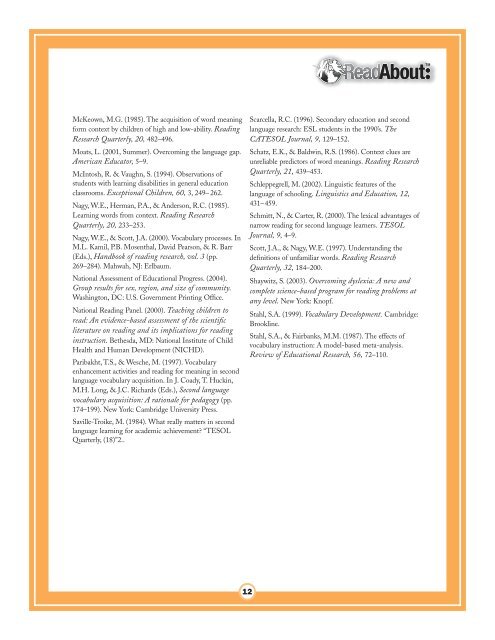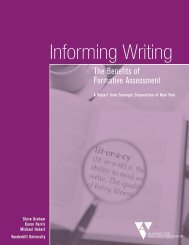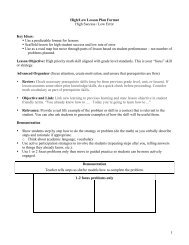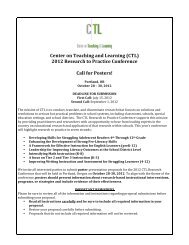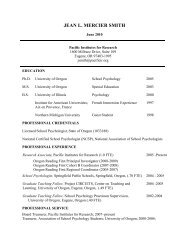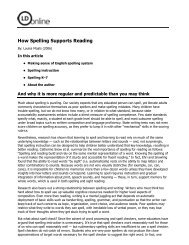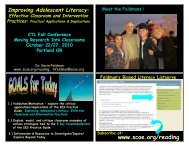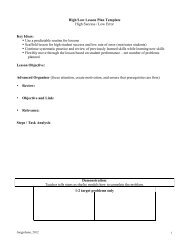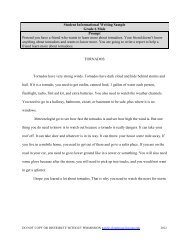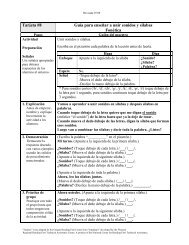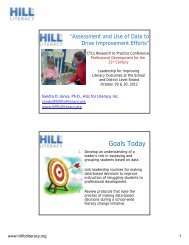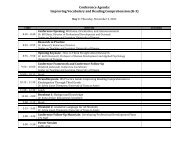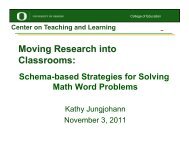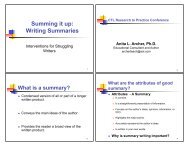Narrowing the Language Gap: - Center on Teaching and Learning ...
Narrowing the Language Gap: - Center on Teaching and Learning ...
Narrowing the Language Gap: - Center on Teaching and Learning ...
- No tags were found...
Create successful ePaper yourself
Turn your PDF publications into a flip-book with our unique Google optimized e-Paper software.
TMMcKeown, M.G. (1985). The acquisiti<strong>on</strong> of word meaningform c<strong>on</strong>text by children of high <strong>and</strong> low-ability. ReadingResearch Quarterly, 20, 482–496.Moats, L. (2001, Summer). Overcoming <str<strong>on</strong>g>the</str<strong>on</strong>g> language gap.American Educator, 5–9.McIntosh, R. & Vaughn, S. (1994). Observati<strong>on</strong>s ofstudents with learning disabilities in general educati<strong>on</strong>classrooms. Excepti<strong>on</strong>al Children, 60, 3, 249– 262.Nagy,W.E., Herman, P.A., & Anders<strong>on</strong>, R.C. (1985).<strong>Learning</strong> words from c<strong>on</strong>text. Reading ResearchQuarterly, 20, 233–253.Nagy,W.E., & Scott, J.A. (2000). Vocabulary processes. InM.L. Kamil, P.B. Mosenthal, David Pears<strong>on</strong>, & R. Barr(Eds.), H<strong>and</strong>book of reading research, vol. 3 (pp.269–284). Mahwah, NJ: Erlbaum.Nati<strong>on</strong>al Assessment of Educati<strong>on</strong>al Progress. (2004).Group results for sex, regi<strong>on</strong>, <strong>and</strong> size of community.Washingt<strong>on</strong>, DC: U.S. Government Printing Office.Nati<strong>on</strong>al Reading Panel. (2000). <strong>Teaching</strong> children toread: An evidence-based assessment of <str<strong>on</strong>g>the</str<strong>on</strong>g> scientificliterature <strong>on</strong> reading <strong>and</strong> its implicati<strong>on</strong>s for readinginstructi<strong>on</strong>. Be<str<strong>on</strong>g>the</str<strong>on</strong>g>sda, MD: Nati<strong>on</strong>al Institute of ChildHealth <strong>and</strong> Human Development (NICHD).Paribakht, T.S., & Wesche, M. (1997). Vocabularyenhancement activities <strong>and</strong> reading for meaning in sec<strong>on</strong>dlanguage vocabulary acquisiti<strong>on</strong>. In J. Coady, T. Huckin,M.H. L<strong>on</strong>g, & J.C. Richards (Eds.), Sec<strong>on</strong>d languagevocabulary acquisiti<strong>on</strong>: A rati<strong>on</strong>ale for pedagogy (pp.174–199). New York: Cambridge University Press.Saville-Troike, M. (1984). What really matters in sec<strong>on</strong>dlanguage learning for academic achievement? “TESOLQuarterly, (18)”2..Scarcella, R.C. (1996). Sec<strong>on</strong>dary educati<strong>on</strong> <strong>and</strong> sec<strong>on</strong>dlanguage research: ESL students in <str<strong>on</strong>g>the</str<strong>on</strong>g> 1990’s. TheCATESOL Journal, 9, 129–152.Schatz, E.K., & Baldwin, R.S. (1986). C<strong>on</strong>text clues areunreliable predictors of word meanings. Reading ResearchQuarterly, 21, 439–453.Schleppegrell, M. (2002). Linguistic features of <str<strong>on</strong>g>the</str<strong>on</strong>g>language of schooling. Linguistics <strong>and</strong> Educati<strong>on</strong>, 12,431–459.Schmitt, N., & Carter, R. (2000). The lexical advantages ofnarrow reading for sec<strong>on</strong>d language learners. TESOLJournal, 9, 4–9.Scott, J.A., & Nagy, W.E. (1997). Underst<strong>and</strong>ing <str<strong>on</strong>g>the</str<strong>on</strong>g>definiti<strong>on</strong>s of unfamiliar words. Reading ResearchQuarterly, 32, 184–200.Shaywitz, S. (2003). Overcoming dyslexia: A new <strong>and</strong>complete science-based program for reading problems atany level. New York: Knopf.Stahl, S.A. (1999). Vocabulary Development. Cambridge:Brookline.Stahl, S.A., & Fairbanks, M.M. (1987). The effects ofvocabulary instructi<strong>on</strong>: A model-based meta-analysis.Review of Educati<strong>on</strong>al Research, 56, 72–110.12


